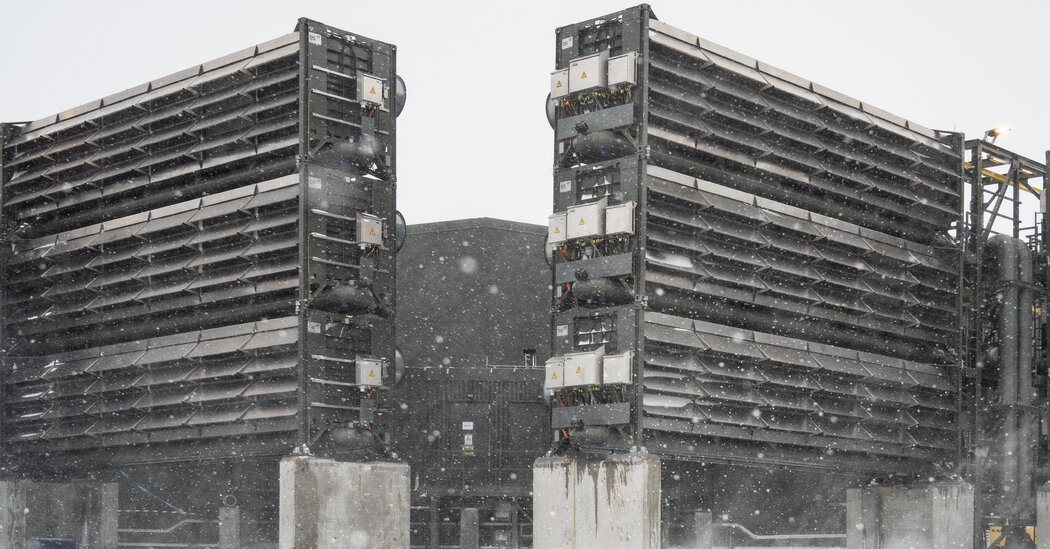Table of Contents
Infusing clouds with sulfur dioxide to block the sun. Vacuuming carbon dioxide out of thin air. Adding iron to the ocean to draw greenhouse gases down to the sea floor. As recently as a few years ago, technologies designed to change Earth’s atmosphere — what is broadly known as geoengineering — were considered too impractical, too expensive and too outlandish to be taken seriously.
But, as I write in a new article, some of these technologies are being deployed. One is already in place.
The effects of climate change are becoming worse. And nations aren’t meeting their collective goal of slashing greenhouse gas emissions. The stakes are very real: Last year was the hottest in modern history. Oceans around the world are shockingly warm. Floods, fires and droughts are growing more intense.
So investors and entrepreneurs are trying — sometimes unilaterally — to fix that. In today’s newsletter, I’ll explain some of those efforts.
Many scientists and environmentalists worry about the safety and efficacy of geoengineering. And some of the best-funded projects are bankrolled by the very oil and gas companies most responsible for the greenhouse gas emissions. Still, plans to intentionally tinker with the planet’s atmosphere are racing ahead.
Underground bubbles
On a warm winter day last month, I traveled to a massive construction site outside Odessa, Texas. There, Occidental Petroleum is building the world’s largest direct air-capture plant. The company plans to turn it on next year.
The mechanics are relatively straightforward: Giant fans blow air across water that has been treated to absorb carbon dioxide. Occidental then uses chemicals to isolate that CO2, mixes the gas with water and pumps it underground. Extreme subterranean pressure keeps the gas locked away forever.
Occidental told me that most of the carbon dioxide it captures will be sequestered in bedrock, removed from the atmosphere for good. But at least some will be used to extract yet more oil from the ground, creating more of the greenhouse gases that are dangerously heating the planet. Earlier this year, I toured a similar factory in Iceland. That one, built by a Swiss company called Climeworks, doesn’t sell any of its CO2 to oil companies.
Other attempts to tweak the climate are still in their infancy. A California start-up claimed to have released sulfur dioxide into the atmosphere in Mexico without permission, hoping to block solar radiation. (Afterward, Mexico imposed a ban on the process.) Researchers in Massachusetts are investigating whether they could generate blooms of phytoplankton that would absorb carbon dioxide and settle on the sea floor.
Who has the power?
Critics of the air-capture plants like those in Texas and Iceland remain skeptical. The projects are enormously expensive and very energy-intensive and snag only a sliver of annual greenhouse gas emissions. Maybe they distract policymakers from the more urgent work of reducing fossil fuel emissions.
Despite these concerns, the market for these ventures is set to boom — from less than $10 billion today to as much as $135 billion by 2040, according to Boston Consulting Group. Occidental is planning to build 100 plants in the coming years, funded in part by $1.2 billion in funding for the technology from the Biden administration. Climeworks wants to build in Kenya, Canada, Europe and Louisiana.
It’s not unusual for a new technology to gain momentum before the major questions about its efficacy, safety and regulation are resolved. Who deserves the right to alter the planet, and what burdens of proof should they first meet?
Right now, there are no international standards governing these new technologies, even though they could affect the whole planet. As one professor of environmental philosophy told me, “We don’t have a great track record of sustained global cooperation.”
For more: Read David’s reporting in Iceland, where carbon capture is a small but growing business.
THE LATEST NEWS
Israel-Hamas War
Meaning: The peace sign, which was designed in the 1950s, was once a powerful symbol for antiwar and countercultural movements. Now, for younger generations, the sign is little more than an anodyne lifestyle motif.
“I take one look at the peace sign, and it feels really dated and meaningless,” a 22-year-old college junior told Michael Rock, a designer and academic. “It reminds me of being in elementary school, and this was on everybody’s water bottles or T-shirts.”
Read more about how the sign’s resonance has changed.


